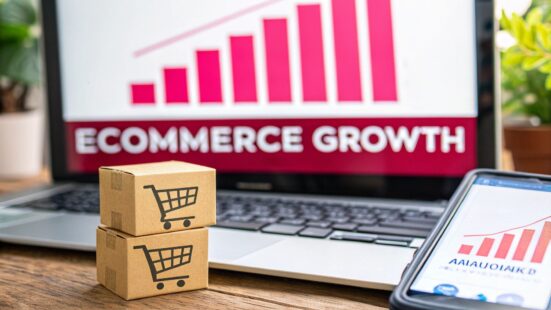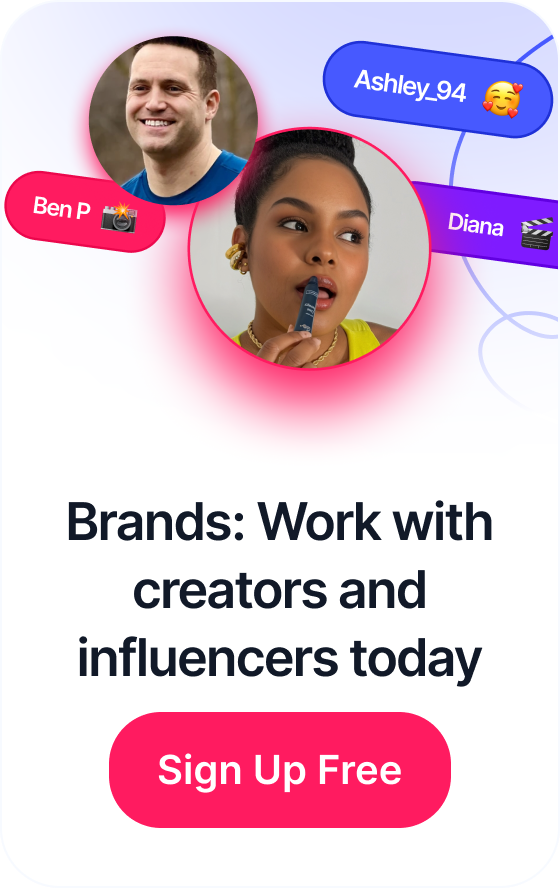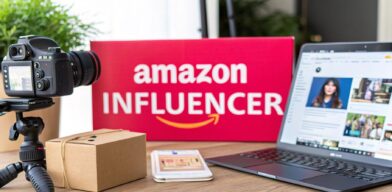 Your New Product Launch Strategy Playbook
Your New Product Launch Strategy Playbook
Driving real growth in ecommerce isn't about finding a single magic bullet. It’s about building a solid strategy that enhances every single touchpoint a customer has with your brand. This means looking at everything from the nuts and bolts of your website's user experience (UX) to launching smart, multi-channel marketing campaigns and using data to keep customers coming back.
At the end of the day, sustainable growth comes from converting more visitors, increasing their average order value, and encouraging repeat purchases.
Table of Contents
Your Blueprint for Driving Real Ecommerce Growth
Let’s be honest—simply having a great product isn’t enough anymore. The ecommerce space is packed, and you can't get ahead with generic advice. This guide goes beyond the obvious to give you a battle-tested blueprint for growth. We're going to break down how to completely transform a customer's journey, from their very first click all the way to becoming a loyal fan.
While the market is still growing, that growth isn't a given. For example, U.S. ecommerce sales growth slowed to 5.3% year-over-year in Q2 2025, which is the slowest it's been since late 2022. Even though that still beat total retail growth, it’s a clear signal that brands have to get smarter and more strategic. You can read more on recent ecommerce sales trends here. This means focusing on the actionable techniques top brands are using to sharpen their operations and marketing.
What This Guide Covers
This isn't just a random list of tips; it's a playbook for navigating the modern digital marketplace. We're going to explore how to:
- Turn Your Digital Storefront Into a Sales Engine: We’ll dive into practical conversion rate optimization (CRO) and UX tactics that actually turn browsers into buyers.
- Expand Your Reach with Multi-Channel Marketing: You'll learn how to build a resilient marketing strategy that finds high-intent customers on the platforms they already love and use.
- Use Data to Drive Personalization and Sales: We’ll show you how to dig into your analytics to really understand customer behavior and deliver those personalized experiences that make a difference.
- Build Loyalty Beyond the First Purchase: Discover the post-purchase strategies that turn one-time buyers into genuine brand advocates, creating a growth engine that keeps on giving.
The secret to increasing ecommerce sales isn’t one trick; it's the consistent, disciplined application of proven strategies across your entire business. From your site’s layout to your email follow-ups, every little detail adds up to create the customer experience—and ultimately, your bottom line.
A huge part of this foundation is having compelling storytelling and messaging. For a deeper dive on that, check out our guide on applying content marketing best practices to your strategy.
Turning Your Digital Storefront Into a Sales Engine
Think of your website as your most valuable salesperson. It works 24/7, never calls in sick, and has the potential to connect with thousands of customers at once. But just like any top performer, it needs constant coaching and tuning. To really drive e-commerce sales, you need to be obsessed with user experience (UX) and conversion rate optimization (CRO), turning casual window shoppers into loyal, paying customers.
The numbers don't lie. US retail e-commerce sales are expected to hit a massive $1.19 trillion in 2024, which is a staggering 24.6% leap from the year before. And it's not slowing down—projections point toward $1.72 trillion by 2027. Grabbing your piece of that pie means your digital storefront has to be more than just pretty; it has to be a ruthlessly efficient sales machine.
Make Finding Products a Breeze
Have you ever walked into a messy, disorganized store where you can't find anything? You probably walked right back out. Your website is no different. If a visitor can't figure out where to go in a few seconds, they're gone, likely heading straight to your competitor.
It all starts with a clean, intuitive navigation menu. Use logical categories and labels that your customers actually understand. A "Shop" menu broken down into clear subcategories like "Men's," "Women's," and "Accessories" will always outperform clever but confusing names.
And don't forget about search. A powerful on-site search bar is absolutely non-negotiable. It needs to handle typos, understand synonyms, and deliver relevant results instantly. It's the digital equivalent of a helpful store employee pointing a customer in the right direction.
Design Product Pages That Actually Sell
This is it—the moment of truth. Your product pages are where a customer decides to click "add to cart" or hit the back button. This is your chance to really show off what you're selling and put any of their doubts to rest.
Here’s how to make those pages work harder for you:
- Bring Products to Life with Visuals: Don't skimp here. Use multiple high-resolution photos from every angle, add a 360-degree view, and if you can, include a short video showing the product in action. People want to see it.
- Write Descriptions That Connect: Move beyond just listing technical specs. Tell a story. How does this product solve a problem or make someone's life better? Use bullet points to call out the key benefits so people can scan them easily.
- Build Trust with Social Proof: Nothing sells a product better than seeing other people love it. Feature customer reviews, star ratings, and user-generated photos and videos right on the page. It’s incredibly powerful for easing purchase anxiety.
The image below really drives home how crucial a mobile-first approach is to your overall site strategy.

As you can see, thinking about mobile isn't just one part of the puzzle; it's the foundation of a modern UX that lifts conversions on every single device.
To give you a quick reference, here’s a breakdown of some high-impact tactics you can implement right away.
High-Impact Website Optimization Tactics
| Optimization Tactic | Primary Goal | Example Action |
|---|---|---|
| Intuitive Navigation | Reduce friction & bounce rate | Create clear, descriptive menu categories and subcategories. |
| High-Quality Visuals | Increase desire & confidence | Add multiple product photos, 360-degree views, and demo videos. |
| Compelling Copy | Connect with customer needs | Write benefit-driven descriptions that tell a story about the product. |
| Social Proof Integration | Build trust & credibility | Display customer reviews, ratings, and user-generated photos prominently. |
| Frictionless Checkout | Decrease cart abandonment | Offer guest checkout and multiple payment options like Apple Pay or BNPL. |
| Mobile-First Design | Improve user experience | Ensure every page is fully responsive and easy to use on a smartphone. |
These are the core areas where small tweaks can lead to significant gains in your conversion rates.
Streamline Your Checkout to Stop Losing Sales
Cart abandonment is the silent killer of so many e-commerce businesses. A clunky, long, or confusing checkout process is often the main culprit. Your mission is to make buying from you as fast and painless as possible.
The moment a customer clicks "checkout," your job is to get out of their way. Remove every unnecessary field, step, and distraction. A simplified checkout is a profitable checkout.
Here are a few quick wins to clean up your checkout flow:
- Offer Guest Checkout: Forcing someone to create an account is a massive roadblock. Let them buy as a guest. Always.
- Use a Progress Bar: Show people exactly where they are in the process (e.g., Shipping > Payment > Review). It reduces anxiety and keeps them moving forward.
- Provide Multiple Payment Options: Cover all the bases. Offer credit cards, PayPal, Apple Pay, and even Buy Now, Pay Later (BNPL) services to suit everyone's preferences.
- Be Upfront About Costs: Nobody likes surprises. Unexpected shipping fees and taxes are the #1 reason people abandon carts. Show the full cost early on.
If you want to dive deeper into building a comprehensive plan for growth, check out these powerful ecommerce growth strategies that go hand-in-hand with a perfectly tuned website.
Stop Guessing, Start Testing
You don't have to rely on gut feelings to know what works. A/B testing (or split testing) is your secret weapon. It lets you scientifically compare two versions of a page to see which one performs better. This data-driven approach takes the guesswork out of optimization.
You can start small by testing high-impact elements. Try a different color for your call-to-action (CTA) button. Test a new headline. See what happens when you rearrange your product page layout. Even a tiny change, like switching your button text from "Buy Now" to "Add to Bag," can produce a meaningful lift in your conversion rate and put more money in your pocket.
Expand Your Reach with Smart Multi-Channel Marketing
Relying on a single marketing channel is like building your house on one pillar. It's a risky strategy. To see real, sustainable growth in ecommerce sales, you need a smart, multi-channel approach that puts you in front of high-intent customers right where they hang out online. The idea is to weave a consistent brand story across every channel, making each touchpoint a smooth step toward a sale.
This isn't just about being on multiple platforms; it's about making them work together. Your organic search, paid ads, social media, and email marketing should all be part of one cohesive system. When you get this right, you don't just expand your reach. You build the kind of brand trust that turns casual browsers into loyal customers.

Dominate Search with Practical Ecommerce SEO
Think of Search Engine Optimization (SEO) as your long-term engine for free, qualified traffic. Unlike paid ads—where the visitors disappear the second you stop paying—a solid SEO foundation consistently brings in people who are actively searching for what you sell.
Start with the basics: your product pages. Every single page needs a unique, keyword-rich title tag and meta description. This is your first impression in the Google search results, so make it count. Don't just stuff in your primary keyword; add a compelling benefit like "Free Shipping" or "Organic Cotton" to stand out.
But you can't stop at product pages. A smart content strategy is non-negotiable. You need to be creating blog posts, buying guides, and comparison articles that answer the real questions your audience is asking. If you sell skincare, a guide like "How to Build a Morning Skincare Routine" positions you as the expert and grabs customers early in their buying journey.
Launch Paid Ad Campaigns with Real ROI
While SEO is a marathon, paid advertising on platforms like Google Ads and Meta (for Facebook and Instagram) is a sprint that delivers immediate traffic. The secret to avoiding a black hole of ad spend? Laser-focused targeting and obsessive optimization.
For any ecommerce brand, Google Shopping campaigns are a must. These aren't just text ads; they're visual storefronts right in the search results, showing your product image, price, and brand name. This format is a magnet for high-intent clicks. Your first step should be to meticulously optimize your product feed with high-quality images and keyword-rich titles.
Over on Meta, the real power lies in retargeting. You can build hyper-specific custom audiences of people who have:
- Visited your website
- Added an item to their cart but bailed
- Bought from you in the past
Now, you can hit these groups with ads that speak directly to where they are in the funnel. For that cart abandoner, an ad showing the exact product they left behind—maybe with a little 10% off nudge—can be shockingly effective at closing the deal.
So many brands make the mistake of treating paid ads like a faucet they can just turn on and walk away from. The most profitable campaigns I've ever run involved daily check-ins on key metrics like Cost Per Acquisition (CPA) and Return On Ad Spend (ROAS), followed by constant tweaking of bids, creative, and targeting. It's a hands-on game.
Foster an Engaged Social Media Community
Social media isn't just another place to shove your products in people's faces. It's where you build a community. Here, authenticity is everything. Ditch the endless stream of perfect product shots and start sharing behind-the-scenes content, user-generated photos, and interactive polls.
A sustainable fashion brand, for instance, could post a raw video tour of its factory or feature customers showing off how they style their pieces. This is the kind of content that builds a real human connection. It makes people feel like they’re part of your brand's story, not just a number on a sales report.
Play to the strengths of each platform:
- Instagram Reels & TikTok: Create quick, punchy videos showing your products in action or offering helpful tips.
- Instagram Stories: Use the poll, quiz, and "Ask Me Anything" features to have real conversations with your followers.
- Facebook Groups: Create a dedicated community for your biggest fans to connect with each other and your brand.
The global ecommerce market is still on a massive upward trend, with sales expected to reach $6.56 trillion in 2025. While the explosive growth is leveling off a bit, the sheer size of this market shows there's huge opportunity for brands that connect with customers effectively across all their digital hangouts. You can dig into more detailed projections about global ecommerce sales growth on oberlo.com.
Convert and Retain with Strategic Email Marketing
Year after year, email marketing delivers one of the highest ROIs of any channel out there. It’s your direct line to people who have literally raised their hands and said, "Yes, I want to hear from you." The magic isn't in just sending emails; it's in segmentation and automation.
Stop blasting your entire list with the same generic message. Instead, slice your audience into segments based on their actual behavior. For example, you could create groups for:
- First-time buyers
- VIP customers who buy from you all the time
- Subscribers who've browsed a specific product category
From there, you build automated email sequences (or "flows") to nurture those relationships at scale. A "Welcome Series" can introduce your brand story to new subscribers and offer a small discount to get that first sale. A "Cart Abandonment" flow can automatically remind shoppers what they left behind. These automated campaigns are like having a sales team working for you 24/7, driving sales without you lifting a finger.
Using Data and Personalization to Drive More Sales
In today's market, just guessing what your customers want is a surefire way to get left behind. The real secret to growing ecommerce sales is getting to know your audience on a much deeper level and using that insight to build shopping experiences that feel like they were made just for them.
This is where your data becomes your most powerful tool.
When you actually dive into your analytics, you stop making broad assumptions and start making data-backed decisions. It’s the difference between shouting into a crowd and having a genuine one-on-one conversation. Modern tools give you the power to see not just what people buy, but why they buy it, what they look at first, and what causes them to click away.
Key Metrics That Tell the Real Story
You don't need to track a hundred different data points to get started. Honestly, it's better to focus on a few vital metrics that directly show you the health of your business and how happy your customers are.
Think of these as the main gauges on your ecommerce dashboard. Start with these essentials in a tool like Google Analytics:
- Average Order Value (AOV): This is simply the average amount each customer spends when they check out. Pushing your AOV up is one of the quickest ways to grow revenue without needing a single new visitor.
- Customer Lifetime Value (CLV): This number predicts the total amount of money you can expect from a single customer over their entire relationship with your brand. A high CLV is a fantastic sign that you're building real loyalty.
- Conversion Rate: The classic. This is the percentage of visitors who actually make a purchase. It’s the ultimate measure of how well your site convinces people to buy.
- Cart Abandonment Rate: We've all been there. This shows you how many shoppers add items to their cart but bail before paying. A high rate here almost always points to some kind of friction in your checkout flow.
Keeping an eye on these numbers gives you a clear, actionable picture of what’s working and what’s not. A stubbornly low AOV might tell you it's time to experiment with product bundles. A high cart abandonment rate? That's your cue to simplify your checkout process, fast.
Turning Raw Data into Personalized Experiences
Collecting data is only half the job. The real magic happens when you use it to personalize the entire customer journey. Personalization makes shoppers feel seen and understood, which is exactly what builds the trust needed to drive sales.
It’s no surprise that research shows 71% of consumers now expect companies to deliver personalized interactions.
Don't think of personalization as just another marketing tactic. It's a fundamental shift in how you talk to your customers. It's about delivering the right message, to the right person, at the right time.
Of course, this means you need to get that personalized content in front of the right people. You can learn more about how to do that by exploring different content distribution strategies that make sure your message lands with real impact.
Putting Personalization into Action
So, what does this actually look like in practice? It’s about creating small, smart interactions that add up to a much better experience. You don't have to get super complex to be effective.
Here are a few practical ways you can start personalizing today:
- Dynamic Product Recommendations: This is a classic for a reason—it works. Use a customer’s browsing history and past purchases to suggest products they'll actually care about. If someone just bought a new camera, it makes sense to recommend a compatible lens or a camera bag, not another camera.
- Segmented Email Campaigns: Please, stop sending the same email blast to your entire list. Segment your subscribers based on their purchase history, how often they engage, or even what they’ve looked at on your site. A first-time buyer needs a very different welcome message than a loyal VIP customer.
- Behavior-Triggered Pop-Ups: Instead of hitting every visitor with the same generic "10% off" pop-up, trigger your offers based on their actions. For example, if someone is lingering on a product page and their mouse moves toward the exit, you could show a pop-up offering free shipping for that specific item.
These kinds of data-driven efforts create a much more intuitive and helpful shopping journey. When you show customers you understand what they need, they're far more likely to reward you with their business—not just once, but for years to come.
Building Loyalty and Trust Beyond the First Purchase
So you made the sale. Awesome. But that's not the finish line—it’s actually the starting gun for what could be a long, profitable customer relationship. While everyone obsesses over getting new customers, the real secret to sustainable growth is turning those first-time buyers into die-hard fans.
This whole post-purchase phase is where you forge the trust that keeps people coming back and skyrockets your customer lifetime value (CLV).
Think about it: a staggering 90% of shoppers say a good post-purchase experience is just as important as the product itself. If you drop the ball here, you're basically spending all your marketing dollars to fill a leaky bucket. You’re losing the very customers you just worked so hard to win over.

Nail Your Post-Purchase Communication
The second a customer clicks "buy," a little bit of anxiety kicks in. Did my order go through? When will it ship? Your first job is to crush that uncertainty with clear, proactive communication.
Don't leave them guessing. An automated email sequence should fire off immediately to confirm the order and lay out a clear timeline for shipping and delivery. Better yet, use a branded tracking page instead of just kicking them over to the FedEx or UPS site. It keeps them in your world and gives you another shot to show off new products or share cool content.
Offer Customer Support That Actually Solves Problems
Let's be real: things go wrong. Packages get delayed, an item shows up damaged, or a customer just has a simple question. How you handle these moments is what truly defines your brand. In fact, great customer service can spin a frustrating situation into an experience that builds even more loyalty.
Make it dead simple for customers to find help. Offer support across multiple channels like email, live chat, and social media. More importantly, empower your team to actually fix problems without needing to escalate everything up the chain.
A few ways to turn your support into a secret sales driver:
- Self-Help Resources: Build out a killer FAQ page. It can solve common issues in seconds, freeing up your team to tackle the trickier stuff.
- Proactive Check-Ins: If a shipment hits a snag, be the first one to tell the customer. Let them know what's happening and what you're doing about it.
- A Personal Touch: Ditch the canned responses. A simple, personalized reply shows you see them as a human, not just a ticket number.
Your return policy isn't just a logistical headache; it's one of your most powerful marketing tools. A clear, no-fuss return process removes a huge barrier to buying and shows you stand behind your products 100%.
Create a Loyalty Program People Actually Use
A solid loyalty program gives customers a real, tangible reason to shop with you again. The secret is keeping it simple. Nobody wants to pull out a calculator to figure out a complicated points system—they'll just ignore it.
Instead, focus on creating obvious value. Offer tiered rewards that unlock better perks as customers spend more. Think early access to new drops, exclusive discounts, or free shipping for life. A brand like Dossier, for example, clearly shows the price difference on product pages for members versus non-members, making the benefit of joining a total no-brainer.
Turn Customer Reviews into Powerful Social Proof
Your happiest customers are your best salespeople. Period. Encouraging and showcasing reviews and user-generated content (UGC) builds an insane amount of credibility. When a new shopper sees real people raving about your products, it instantly validates their decision to buy from you.
Set up an automated email to go out a week or two after delivery asking for a review. Make it frictionless—let them leave a rating and a comment with just a couple of clicks. You can even incentivize them with a small discount on their next order for their feedback.
Then, plaster those authentic reviews everywhere: on your product pages, your homepage, and all over your social media feeds. This creates a powerful, self-sustaining cycle of social proof that does the selling for you.
Got Questions About Ecommerce Growth? We've Got Answers.
As you start putting new growth strategies into play, some questions always seem to surface. Let’s tackle the big ones head-on so you can cut through the noise and focus on what really moves the needle.
What's the Fastest Way to Juice Ecommerce Sales?
If you're looking for an immediate impact, the one-two punch of targeted paid ads and aggressive conversion rate optimization is your best bet. A well-built ad campaign on a platform like Google Shopping or Meta can start funneling high-intent shoppers to your store in a matter of hours.
But getting them there is only half the battle. You have to make sure your site is primed to convert that fresh traffic. Focus on quick wins: A/B test your main call-to-action buttons, make your value prop crystal clear above the fold, and launch a compelling, limited-time offer. This combo of driving new traffic and smoothing the path to purchase creates the quickest possible lift in sales.
How Can I Get Customers to Spend More Per Order?
Boosting your Average Order Value (AOV) is a seriously powerful way to grow revenue without needing a single extra visitor. Instead of chasing more customers, you’re just encouraging each one to add a little more to their cart. It’s all about efficiency.
Here are four tried-and-true tactics to bump up your AOV:
- Bundle Products Together: Offer curated packages of related items at a slight discount. Think "Beginner's Skincare Kit" instead of just selling a cleanser, toner, and moisturizer separately. It feels like a complete solution and a good deal.
- Use Smart Upsells and Cross-sells: As shoppers browse and check out, suggest a slightly better version of a product (an upsell) or a complementary item (a cross-sell). If someone adds a camera to their cart, suggesting a compatible memory card is a no-brainer.
- Set a Free Shipping Threshold: This is a classic for a reason. Motivate customers to add more to their cart by setting a clear goal, like "Free shipping on all orders over $75." You'd be surprised how many people will grab one more thing to avoid a shipping fee.
- Offer Volume Discounts: Encourage larger purchases by offering a small discount for buying multiples. This works especially well for consumables that you know customers will eventually need to reorder anyway.
The secret to a good AOV strategy is making the customer feel like they're getting more value. Your offers should feel like helpful suggestions, not a hard sell.
What Ecommerce Metrics Actually Matter?
You could drown in data, but tracking just a few key performance indicators (KPIs) will give you the clearest view of your store's health. Forget vanity metrics; focus on the numbers that directly tie to your bottom line.
Your essential ecommerce dashboard should include these five:
- Conversion Rate: The percentage of visitors who actually buy something. This is the ultimate report card for your website's effectiveness.
- Average Order Value (AOV): The average amount spent every time a customer checks out.
- Customer Lifetime Value (CLV): The total amount of money you can expect from a single customer over their entire relationship with your brand.
- Customer Acquisition Cost (CAC): How much you have to spend on sales and marketing to get one new customer.
- Cart Abandonment Rate: The percentage of shoppers who add items to their cart but bail before paying.
Keeping an eye on these five metrics helps you spot problems and opportunities quickly. For example, if your CAC is higher than your AOV for a first-time buyer, you know your business model isn't sustainable without a rock-solid retention plan.
Should I Focus on Getting New Customers or Keeping the Ones I Have?
It's the age-old ecommerce dilemma, but the data is pretty clear on this one. While you need both to grow, customer retention is dramatically more cost-effective and profitable over the long haul.
Bringing in a new customer can cost up to five times more than keeping an existing one. On top of that, loyal, repeat customers tend to spend more over time, have a higher AOV, and become your best marketers through word-of-mouth.
The best approach is a balanced one. Use channels like SEO and paid ads to keep a steady stream of new people coming in. But, you absolutely should be investing heavily in strategies like email marketing, incredible customer service, and loyalty programs to turn those first-time buyers into lifelong fans.
Ready to amplify your brand's voice and drive sales with authentic content? JoinBrands connects you with over 250,000 creators to produce high-impact UGC and influencer campaigns that convert. Start your campaign today!








